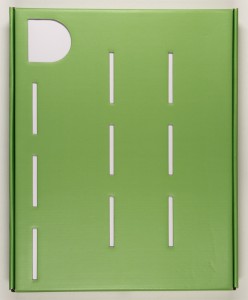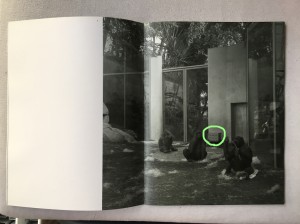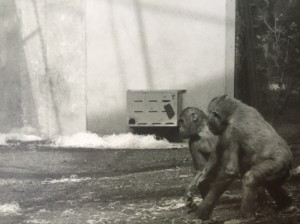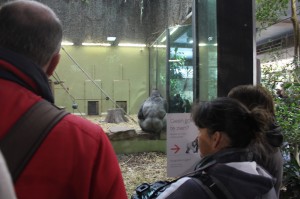The first indication given to us about this assignment was to select a book based solely on its design. As soon as this information was delivered the first thing that popped into my mind was to find one that would present the most extravagant, out of the box features, so that whatever the next steps to follow would be, the subject matter could not be accused of being boring.
Ironically enough, I chose a book that is inside a box. Which actually was the main reason it outshone its shelf mates, that suddenly looked very serious with their glue bind cover.
Puzzle box by Ines Lechleitner is an artist book released in 2009. I was momentarily skeptical at the functionality of its green gapped cardboard cover —not that it mattered to my eyes, since the pick was based on unconventionality—, or to put it in a way that fits better the central reasoning that led to my choice, maybe the fact that it would present an additional layer to access its content, or remind the feeling of opening a present, would make it more interesting. Soon, the content justified the packaging: it is composed by two books one being the artist’s work where you can find pictures of a group of gorillas in a German zoo and drawings that explain the movements made by the camera. The second one being a response of different authors to the work carried out. Then, two videos were also included — found as a CD in the book— that focus on the gorillas entering and leaving the frame, and finally, a map of the relations between the gorillas’ habitat, the photographs and videos. The box now seemed like a handy support to carry the CD and the map.
You can find the true reasoning behind the design in the author’s website: «Puzzle Box is modeled after ‘Beschäftigungskästen’, which were designed specifically for apes as an interactive occupation and recreation tool. The apes are expected to learn how to manipulate grains inside the box by pushing them from one level to the next in order to gain access to the food.»
This box was inside the gorilla’s location and is recurrently found throughout the images of the book
As I mentioned earlier the book contains a response of different authors to the work. It was captured as a conversation between the artist and the authors. When I finished reading it, I imagined myself participating in that conversation. To get more insight on what the artist had experienced over the period of 5 years in which she developed this project I decided to go to the Amsterdam zoo to elaborate my response.
I quickly began to make associations. The humans standing there encircling the gorillas’ cage while expressing their reactions could be similar to the way the gorillas manipulate the Beschäftigungskästen, both actions are driven by the effect, even if in the first case it might be entertainment and in the latter obtaining some food. It is interesting to consider the sizes of those involved in this equation and the movement of this idea which goes inwards in distance. Us humans look at the cage and touch the glass with our fingers while inside, the gorillas look at the box touching it to get some food. And even taking it further, while manipulating the box the gorillas fell into it, furthering the confinement, satisfying the humans need for entertainment and consumerism now possible through the Puzzle Box in which they lie. Definitely, I noticed how much my perception of the zoo as a place had shifted since I was a child.
There are five polar notions that get emphasized in the book
we/them
open/closed
active/passive
space/movement
In the frame (onscreen)/ out of the frame (offscreen)
The pictures in black and white somehow make stronger the sensation of two different entities separated by distance. The framing delimits the space in a way that makes you wonder what is around, almost as if each picture wasn’t complete or was a piece of a puzzle. It also happens with the video where you would need a 360º panorama to understand the full set. The pace in which the gorillas are depicted is calm, almost uninterested.
In the zoo, once I spent enough time with the gorillas and my brain ended up getting used to the extreme, overwhelming aroma, I was able to truly concentrate on their movements, realizing how much more aware I was becoming of my own. I felt there was a strong relation between this feeling and the fact that the whole work of the artist (the map, the video, the pictures and the drawings) was to know very precisely, almost memorizing, each step and movement of the gorillas knowing what movement it was, which place were they occupying in space, when they did it, all of it systematically. This is also linked to the book’s design that appears to be calculated, calm and neat, using the same typewriter font throughout the book, and clean ‘one-line’ drawings.
Remembering that humans possess in a 98% the same DNA than gorillas I suddenly felt funny imagining my movements being dissected in a book.
Puzzle Book, designer: Ines Lechleitner, Rietveld Library Cat. no: lec 1



